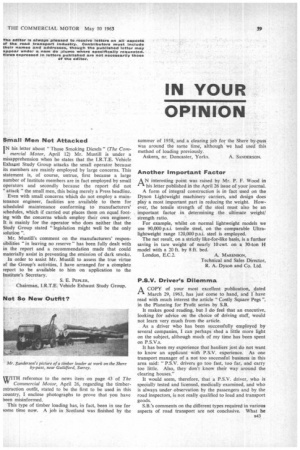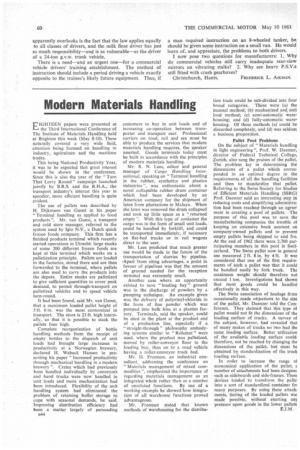IN YOUR OPINION
Page 61

Page 62

If you've noticed an error in this article please click here to report it so we can fix it.
Small Men Not Attacked
TN his letter about "Those Smoking Diesels" (The ComI mercial Motor, April 12) Mr. Mustill is under a misapprehension when he states that the I.R.T.E. Vehicle Exhalist Study Group attacks the small operator because its members are mainly employed by large concerns. This statement is, of course, untrue, first because a large number of Institute members are in fact employed by small operators and secondly because the report did not "attack " the small men, this being merely a Press headline.
Even with small concerns which do not employ a maintenance engineer, facilities are available to them for scheduled maintenance conforming to manufacturers' schedules, which if carried out places them on equal footing with the concerns which employ their own engineer. It is mainly for the operator who does neither that the Study Group stated "legislation might well be the only solution ".
Mr. Mustill's comment on the manufacturers' responsibilities "in leaving no reserve" has been fully dealt with in the report and a recommendation made that could materially assist in preventing the emission of dark smoke.
In order to assist Mr. Mustin to assess the true virtue of the Group's activities, I have arranged for a cbmplete report to be available to him on application to the Institute's Secretary.
S. E. PEPLER, Chairman, I.R.T.E. Vehicle Exhaust Study Group.
Not So New Outfit?
WITH reference to the news item on page 43 of The Commercial Motor, April 26, regarding the timberextraction outfit, stated to be the first to be used in this country, I enclose photographs to prove that you have been misinformed.
This type of timber loading has, in fact, been in use for some time now. A job in Scotland was finished by the summer of 1958, and a clearing job for the Shere by-pass was around the same time, although we had used this method of loading previously.
Askern, nr. Doncaster, Yorks. A. SANDERSON.
Another Important Factor A N interesting point was raised by Mr. P. F. Wood in his letter published in the April 26 issue of your journal. A form of integral construction is in fact used on the Dyson Lightweight machinery carriers, and design does play a most important part in reducing the weight. However, the tensile strength of the steel must also be an important factor in determining the ultimate weight/ strength ratio.
For example, whilst on normal lightweight models we use 90,000 p..s.i. tensile steel, on the comparable Ultralightweight range 120,000 p.s.i. steel is employed.
The net result, on a strictly like-for-like basis, is a further saving in tare weight of nearly 10 cwt. on a 30-ton H model with a 20 ft. by 8 ft. bed.
London, E.C.2. A. MARE,NBON, Technical and Sales Director. R. A. Dyson and Co. Ltd.
P.S.V. Driver's Dilemma A COPY of your most excellent publication, dated March 29, 1963, has just come to hand, and I have read with much interest the article "Costly Square Pegs ". in the Planning for Profit series by S.B.
It makes good reading, but I do feel that an executive, looking for advice on the choice of driving staff, would not learn very much from the article.
As a driver who has been successfully employed by several companies, I can perhaps shed a little more light on the subject, although much of my time has been spent on P.S.V.s.
It has been my experience that hauliers just do not want to know an applicant with P.S.V. experience. As one transport manager of a not too successful business in this area said: "P.S.V. drivers go too fast, too far, and carry too little. Also, they don't know their way around the clearing houses."
It would seem, therefore, that a P.S.V. driver, who is specially tested and licensed, medically examined, and who is always under observation by the passengers and by the road inspectors, is not really qualified to load and transport goods.
S.13.'s comments on the different types required in various aspects of road transport are not conclusive. What he B43
apparently overlooks is the fact that the law applies equally to all classes of drivers, and the milk float driver has just as much responsibility—and is as vulnerable—as the driver of a 24-ton g.v.w. trunk vehicle.
There is a need---and an urgent one—for a commercial vehicle drivers' training establishment. The method of instruction should include a period driving a vehicle exactly opposite to the trainee's likely future equipment. Thus, if a man required instruction on an 8-wheeled tanker, he should be given some instruction on a small van. He would learn of, and appreciate, the problems to both drivers.
I now pose two questions for manufacturers: 1. Why do commercial vehicles still carry inadequate rear-view mirrors on vibrating stalks? 2. Why are heavy P.S.V.s still fitted with crash gearboxes?
Christchurch, Hants. FREDERICK L. AIKMAN.
































































































